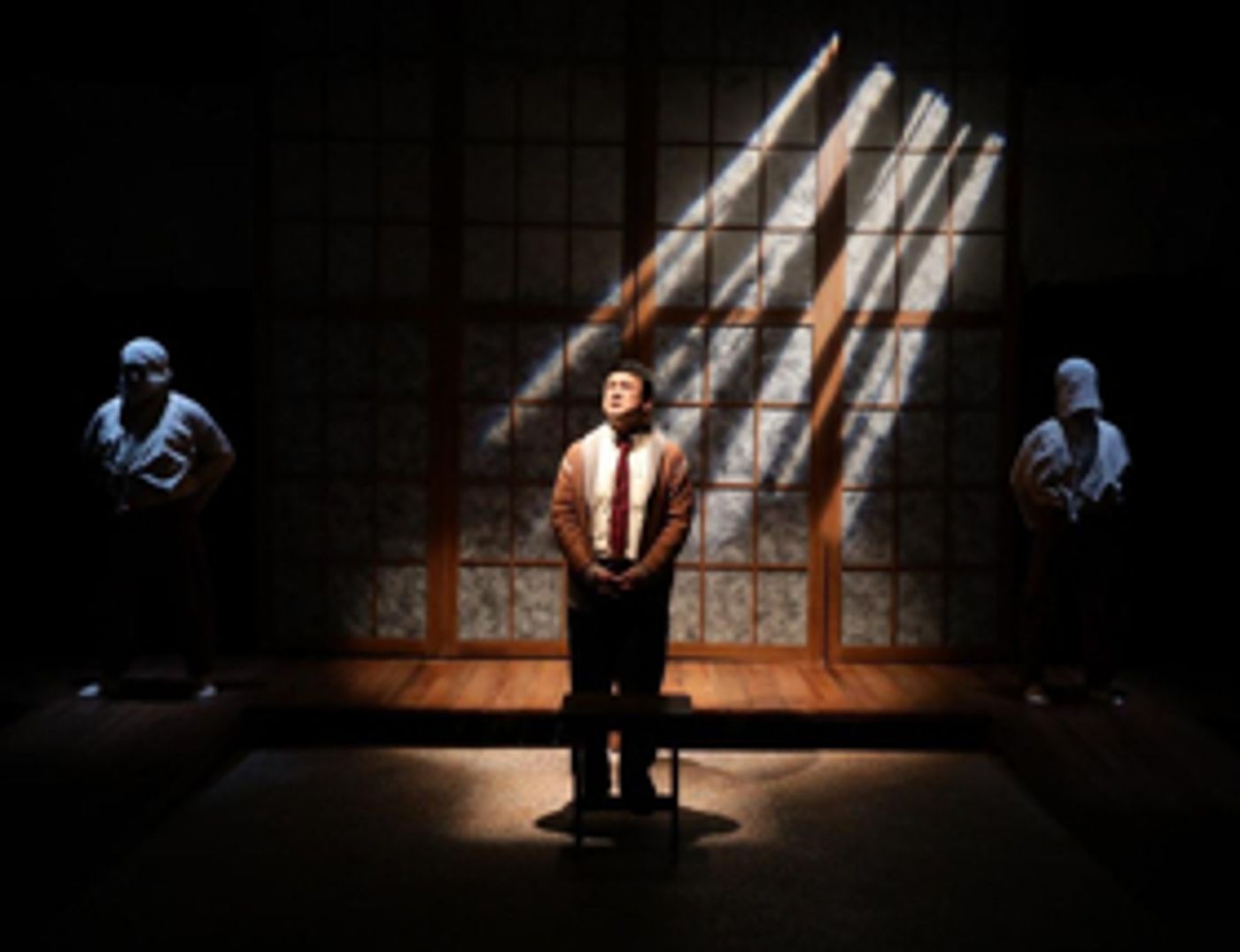Review: HOLD THESE TRUTHS: Past is Prologue

Hold These Truths
Written by Jeanne Sakata, Directed by Benny Sato Ambush; Choreographer, Jubilith Moore; Scenic Design, Shelley Barish; Costume Design, Tobi Rinaldi; Lighting Design, Karen Perlow; Sound Design and Original Music, Arshan Gailus; Projection Design, Johnathan Carr; Dialect Coach, Bryn Austin; Production Stage Manager, Nerys Powell; Assistant Stage Manager, Betsy Pierce
CAST: Michael Hisamoto (Gordon Hirabayashi); Khloe Alice Lin, Gary Thomas Ng, Samantha Richert (kurogos)
Performances through December 31 at The Lyric Stage Company of Boston, 140 Clarendon Street, Boston, MA; Box Office 617-585-5678 or www.lyricstage.com
The Japanese attack on Pearl Harbor occurred on December 7, 1941, and only two and a half months later, President Franklin Delano Roosevelt signed Executive Order 9066 authorizing the forced mass removal and incarceration of approximately 120,000 persons of Japanese descent on the West Coast. Most were United States citizens, but one man stood up and argued that it was a violation of his constitutional rights when he was ordered to report to an internment camp. Hold These Truths is playwright Jeanne Sakata's blending of historical fact with fiction to tell Gordon Hirabayashi's compelling David vs. Goliath story, shining a piercing light on a dark chapter in American history while introducing us to a genuine patriot.
The Lyric Stage Company of Boston eschews a traditional holiday offering and gives us something more substantial and, ultimately, uplifting for the soul. The events of the past that are represented in this play echo much too loudly in our present day reality. As Director Benny Sato Ambush writes in his program note, "Othering is as American as apple pie," and we are seeing an onslaught of "othering" these days, aimed at multiple targets. Although prohibiting entry to the country with the Muslim ban and deportation of undocumented immigrants may not directly impact citizens, both of those actions are first cousins to FDR's order. Driven by nativism and xenophobia, they are the antithesis of so many values we hold dear that are reflected in the U.S. Constitution. While it is depressing to watch what took place in 1942, the strong thread that runs through Hold These Truths is the resistance and persistence practiced by Hirabayashi, as well as the admirable life he made for himself following his incarceration and the end of the war.
Michael Hisamoto brings a genuine smile and heart and soul to the stage for 100 minutes, never wavering in his capacity to make us accept his character's decency and the rightness of his cause. Hirabayashi is grounded in his belief that his status as a natural-born United States citizen entitles him to the same rights and treatment as anyone else, no more, no less. He goes against the inclination to obey what the government orders him to do (as the rest of his family does), realizing that there will be consequences (like jail), because he is standing up for what his country stands for. It sounds a little bit crazy, but that's the crux of the issue. Hisamoto is a delight and conveys easygoing likability, implying that Hirabayashi took it all in stride, as if it were an adventure in real-life civics. What we do know is that he remained positive, despite losing his legal battle, and was posthumously awarded the Presidential Medal of Freedom by President Obama in 2012, a few months after his death.
Hold These Truths is Hirabayashi's story, told mostly in his voice. However, Hisamoto is joined onstage by Khloe Alice Lin, Gary Thomas Ng, and Samantha Richert as kurogos, traditional stage attendants in the Japanese theater forms of kabuki and noh. They do not speak, but portray members of Hirabayashi's family and engage with him, Hisamoto carrying on both ends of their conversations, sometimes in Japanese. The kurogos wear beige garments and gauzy white masks over their heads. Their movements, choreographed beautifully by Jubilith Moore, are stylized and help to illustrate what is happening in the moment. It's hard to explain, but their artistry is as key to the total enjoyment of the play as is Hisamoto's irresistible performance.
The set by Shelley Barish is simple, with wooden ramps on either side of the stage and a series of sliding panels evocative of Japanese design upstage. Projections by Johnathan Carr show scenes of Pearl Harbor, barbed wire, a transport train, etc., to augment the narrative. Karen Perlow's lighting design and Arshan Gailus' original music/sound design add layers of atmosphere and beauty to the production values, while Tobi Rinaldi contributes effective and clever costume design. The work of dialect coach Bryn Austin is reflected in Hisamoto's easy transition among the voices of several characters.
If Hold These Truths were entirely fictional, it would still be riveting, but the truth of the story widens and deepens its emotional impact. The drama is also informed by the ancestry of its director, the offspring of a Japanese-born grandfather and black grandmother. Although her husband died in 1939, Sato Ambush's grandmother lost her right to vote during World War II because she had been married to him. Ironically, her job at the time was registering citizens to vote at Cambridge City Hall. It is not difficult to understand how the play resonates with him, nor to feel Sato Ambush's deeply personal embrace of the material. At this moment, Hold These Truths feels deeply personal for us all.
Photo credit: Mark S. Howard (Michael Hisamoto, with Gary Thomas Ng, Samantha Richert)
Reader Reviews
Videos

